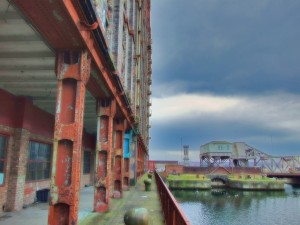Whatever the Risks, it’s people that keep history alive
Liverpool Landscapes was a blog charting new discoveries, news and developments affecting Liverpool's historic environment. It was regularly updated between 2007 and 2016.
Liverpool Landscape has now been retired, and most of the less time-dependent articles moved to Historic Liverpool.

This week we get an updated list of the heritage at risk on Merseyside, see a unique perspective on how Liverpool has changed over the last few decades, plus some personal points of view on Liverpool and its past.
Heritage at Risk: English Heritage (recently split into a charity called English Heritage and a government advisory body known as Historic England) has maintained a list of historic buildings and monuments in poor condition since 1999. I’ve been keeping tabs on Heritage at Risk on Merseyside on this very blog, and now the latest list has been released under the Historic England brand.
The Liverpool Echo has a run-down (pardon the pun) of the vulnerable buildings of Liverpool, and you can search for specifics on the Heritage at Risk pages of the Historic England website. The useful thing about the list is that it monitors changes, rating buildings at ‘improving’ or ‘deteriorating’. So even though developments have taken place in the Stanley Dock Conservation Area, it remains on the HaR list, labelled ‘Improving’. If things carry on as they are now, no doubt this Stanley Dock CA will come off the Heritage at Risk list.
More or less vegetation in Liverpool?: Here’s an interesting set of maps for you. While taking a GIS course on computer mapping, my wife Sue Greaney found a map of Merseyside showing vegetation levels in 1975 and 2010, coupled with a map showing the difference, ie , whether vegetation has increased or decreased in Liverpool over that period. Green areas show increased vegetation cover, blue areas show a decrease.
You may be surprised at what you see! I can’t explain the patterns shown here, although my experience of the city suggests this isn’t beyond the bounds of possibility. What do you think?
Three Personal Views of Merseyside History: There’s no doubt that the passion for history that has emerged over the last few decades has been fuelled by individuals becoming interested for the first time in their past, and in the places they inhabit. The Internet has brought a perfect platform for every one of these people to have a go, share their ideas, and tell the world about their corner of the globe. Here are three great examples, at least one of which regular readers will already know.
- John Davies: John has written an answer to a classic landscape archaeology (or history) essay question – “Choose a landscape which is familiar to you and write about the factors which you think have most influenced its development over the past five hundred years“. And guess where he chose! Liverpool, of course. It’s almost a shortened version of my own book, taking in all the landscape factors which have moulded Liverpool into the shape it is today. It’s much more social history than I usually write about, so it’s a perfect antidote to the type of stuff on Liverpool Landscapes and Historic Liverpool!
- John Viggars: Ronnie Hughes’ A Sense of Place has had a couple of guest posts recently, and the one I’m highlighting is a second by John Viggars, who’s rediscovered photographs of the International Garden Festival. The Festival was possibly one of the very first efforts to rescue Liverpool and Merseyside from the doldrums of the 1970s and 80s, of which the Albert Dock was a similar project. The photos on that blog post are vibrant and colourful, full of dodgy ‘taches and big hair (the latter on the men and women). I have only a couple of memories, being a nipper at the time, but they’re forever-summer memories, and that shows in these photos of the Garden Festival.
- International Lamb of Mystery: a new name on the scene for me, the Lamb in question is Jude Lennon, a professional storyteller for schools who runs Little Lamb Phonics. Jude’s lucky enough to be on the Calderstones Mansion / Reader Org Big Dig, where they’re looking for whatever might be buried in the green green grass of Calderstones Park. Finds are already coming to the surface, and the Lamb of Mystery has blogged about the archaeology, complete with pictures! I shall be following this blog as another channel to bring me news of the Big Dig. I’m very jealous!
It all goes to show that even when looking across the great sweep of history, it’s the individuals who bring it to life for us. I hope I do something of this, but at least I know that there are others out there too who are keeping the flame alive.
I just want to remind you all too that the Historic Liverpool Shop is now open, selling my book, cases, mugs and more with the old maps of Liverpool on. There’s also a Historic Liverpool Etsy shop if that’s how you like to browse. Please let me know if there’s a custom order you’d like me to put in for a present or similar. Thanks for looking!
Image: Stanley Dock by SDPD, Creative Commons License via Flick.



